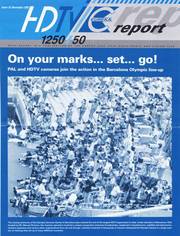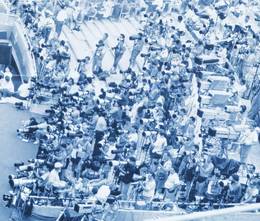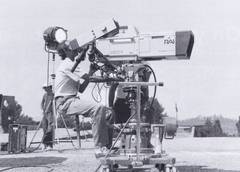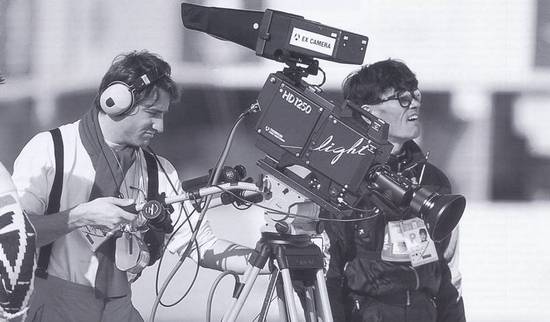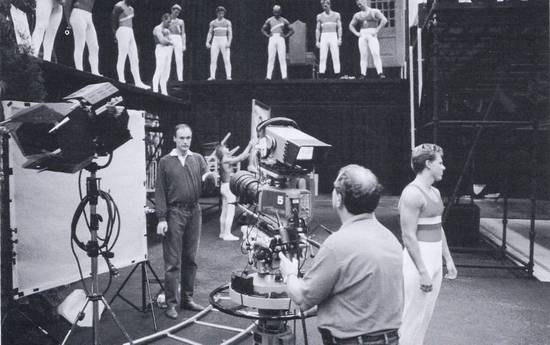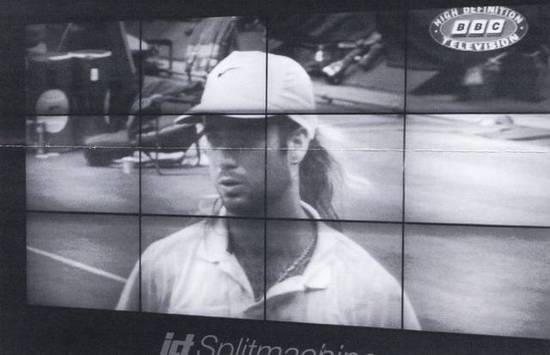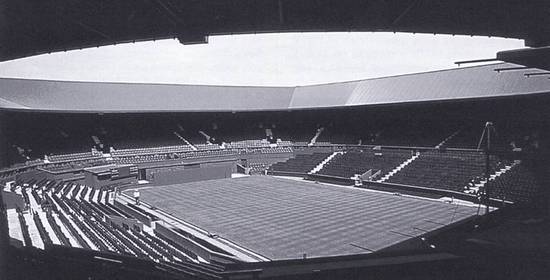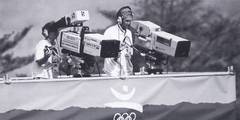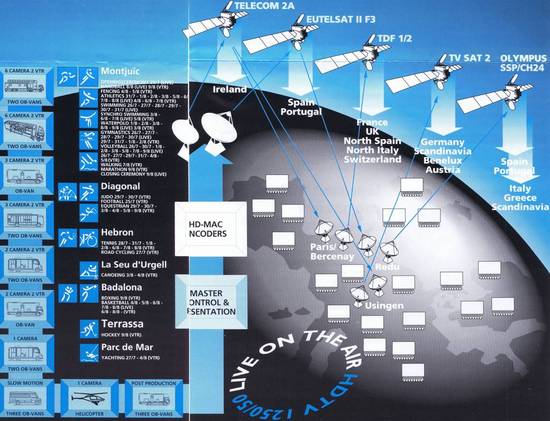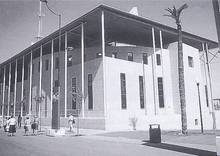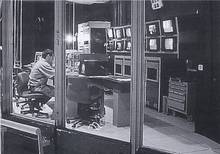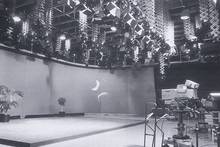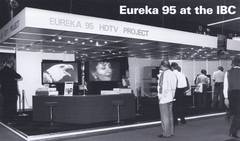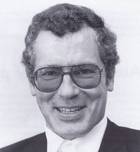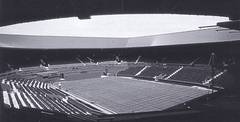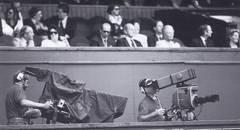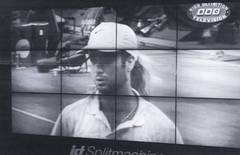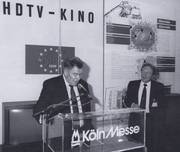Der Eureka Report - issue 10 - Nov. 1992
Von Juni 1990 bis November 1992 erschienen also 8 weitere HDTV-Eureka Reports, die uns nicht vorliegen. Wenn man von den Wiederholungen der diversen Artikel und Betrachtungen in den uns vorliegenden 5 Reports ausgeht, haben die Redakteure sich sehr bemüht, aktuelle Neuigkeiten mit bereits Bekanntem jeweils zu einer "Zeitung" aufzufüllen. Manche Artikel wiederholen sich nämlich zu oft. Und von jetzt an sind alle Artikel nur noch in Englisch - schade. Da der Autor Gert Redlich in den Jahren um 1990 mit der professionellen Fernsehtechnik sowie den publizierten HDTV Entwicklungen nur wenig zu tun hatte, sind diese Reports nie beachtet worden. Hin und wieder kamen in den Abend-Nachrichten zur IFA Informationen über das europäische HDTV Projekt mit oft widersprüchlichen Aussagen, sodaß damals das Interesse an HDTV schnell verloren ging.
.
November 1992 - On your marks ... set ... go !
The closing ceremony of the Olympic Summer Games in Barcelona also marked the end of the largest HDTV experiment to date. Under direction of Barcelona 125 headed by Mr. Manuel Romero, the massive operation involved a unique cooperation between broadcasters, equipment manufacturers, satellite and telecommunication operators and various other organizations from all over Europe. Literally hundreds of thousands of viewers witnessed the Olympic Games in a large number of viewing sites set up in many different countries.
HDTV: a broadcaster's view
As more and more people become familiar with HDTV and the enormous improvements in sound and picture quality it offers, we wondered how the leading European broadcasters feel about HDTV.
When will they be ready to broadcast in high definition? How do they see the future of HDTV and what will be the impact on their organization? What about the financial consequences?
We approached several European broadcasters and asked for their opinion.
RAI:Financing HDTV through subscriptions
Technical Director Mr. Mario Lari joined the RAI in 1955 and is involved in many organizations dealing with the future of television, amongst others the steering committee of the Italian consortium for the development of HDTV in Italy, CISAE, and the steering committee of the Italian consortium for high definition terminals, CITAD.
"Before we can even make a start with a RAI HDTV operating service, various institutional, normative, technical and financial problems must be solved", Mr. Lari says. As an example, he mentions the regulation of satellite broadcasting in Italy, the improvement of the compatibility of the broadcasting standards, and the definition of the characteristics of broadcasting parameters.
ESSENTIAL
"In my opinion, the availability of HDTV receivers of a good quality and at a reasonable price constitutes the essential condition for the realization of the HDTV operative service", Mr. Lari says. He feels that an HDTV service must be entirely financed through ad hoc subscription fees and the proceeds from advertising. Furthermore, he believes that, at least in the start-up phase, national funding and/or community funding is essential to enable the broadcasters to purchase equipment and for the production of HDTV programmes.
MORE
RAI has already produced several HDTV programmes and intends to continue to produce more, taking into consideration that they can also be utilized for transmissions using traditional standards. Mr. Lari feels that the success of HDTV is strictly linked to an improvement in the quality of programmes, and in a technical quality improvement as compared to other services. "We feel that it will take five to six years before the market for HDTV is fully developed. As a consequence, there will only be a few European HDTV-channels initially, located in the most industrialized and most concerned countries."
The realization of a pan-European channel has to be carefully examined, is Mr. Lari's opinion, as it could clash with the general interests of the individual European countries and the individual broadcasters.
Mr. Lari believes that because of the 16:9 screen ratio, sporting events, promotional events and entertainment offers the most suitable material for HDTV programmes. He thinks that RAI will initially broadcast the most spectacular programmes in HDTV, for a total of 10-15% of the total broadcasts. "This percentage will gradually rise with the increase of the availability of means and resources."
France 2: Maintaining cultural identities
Mr. Xavier Drumare is Managing Director of 16:9 HDTV programming for FRANCE 2 (formerly ANTENNE 2), one of two public TV channels in France broadcasting its programmes -24 hours a day- terrestrially all over the country. Since January 1991, all of the channel's programmes are transmitted in D2-MAC via the TDF2 satellite.
"For FR2 satellite broadcasting in the new D2-MAC standard represents a considerable opportunity: it allows us to pursue our investments in digital production technology and of course offers our viewers the benefits of an improved picture and sound quality. Moreover, these programmes can be received all over Europe via satellite thereby enabling us to reaffirm our European ambitions", says Mr. Drumare.
In 1991 FR2 broadcast over 300 hours of programmes in the 16:9 format. "Today it is mainly the appeal of the 16:9 format which is driving the D2-MAC standard: widescreen is clearly the first step in the television revolution which we will witness over the next decade." According to Mr. Drumare, the compatibility between D2-MAC and HD-MAC demonstrates that HDTV has definitely passed from the project phase into an operational phase.
STRATEGY
Mr. Drumare feels that the concerted efforts of certain European broadcasters, such as the RAI, the BBC and of course FR2 have developed a veritable strategy for the development of programme production in the new standard.
"It is our intention to progressively turn our satellite TV channel into a HDTV channel. To this end we are currently reinforcing our strategy for 16:9 programme production and transmission in normal definition for live programmes and in High Definition for stocked programmes."
Mr. Drumare feels that feature films, documentaries, music shows and sport make excellent HDTV programmes. In 1991, FR2 broadcast over 300 hours of HDTV programmes, most of which (over 200) were sports programmes. "Out of this total FR2 has produced more than 130 hours in High Definition, mainly sports and live shows but also cartoons, documentaries and short films. For these programmes the HDTV production hardware was provided by Vision 1250." In addition, FR2 has already broadcast 40 hours of high definition using the European HD-MAC standard.
In 1992, FR2 has significantly developed the established pattern. More money is being invested in stock programmes (documentaries and fiction); production and transmission of sports events -such as the Olympic Summer and Winter Games- is further developed; and more HDTV programmes are produced jointly with producers and broadcasters in Europe.
FR2 hopes to broadcast a total of 750 hours of 16:9 programmes this year, around 50% of which will be produced in high definition and transmitted in HD-MAC.
PRODUCTION EQUIPMENT
Looking at the cost aspects, in the context of a 16:9 production in standard 625 line resolution, when two production systems are needed, the costs are twice as high. "When we produce in HDTV, the additional costs depend on the type of programme. Right now Vision 1250's production hardware is available free of charge to members."
Generally speaking, according to Mr. Drumare, HDTV production equipment is still somewhat less flexible, harder to manage and more time consuming. "There is also a learning curve for the operators. All these factors influence the budget. On the average the additional costs to make an HDTV productions are 10-20%, taking into account the availability of Vision 1250's hardware free of charge. However, when there will a free-market of high definition equipment suppliers, the additional costs, in the early stages, will be significantly higher than this."
Mr. Drumare thinks it vital that no time is wasted and all efforts in Europe are joined to stimulate the European HDTV programme market. "This market is, after all, an essential factor in maintaining our respective cultural identities."
NDR: HDTV must be viable to all existin channels
Professor Dr. U. Reimers, Technical Director of the Norddeutscher Rundfunk (NDR) remarks that broadcasting of D2-MAC and HD-MAC programmes in Germany has started already. "ARD, for example, has been broadcasting its 'Tins Plus" channel in D2-MAC via TV Sat 2 for around five years now. A wide variety of transmissions in HD-MAC, in particular from the Olympic Games in Albertville and Barcelona, have been included in "Eins Plus" programme schedules in 1992. To this extent, there is definitely a certain range of programmes for the planned HDTV sets already in place."
According to Professor Reimers, it is impossible to say when an independent and more-or-less all-day HDTV channel will be available. "I know of no plans in Europe to provide such a service in the medium term, except perhaps for the TV Plus experiment in the Netherlands."
PRODUCTION
Many films, says Professor Reimers, are ideal HDTV material, as are the large numbers of electronic HDTV productions. "Within the framework of the creation of a European Memorandum of Understanding, or the corresponding plan of action, the ARD too has expressed interest in producing further programmes for the Eins Plus channel at such a time as EC funding of the level announced (850 million Ecu) is available - in this case, however, with a ratio of 16:9."
CHOICE
Professor Reimers sees opportunities for HDTV in the area of applications outside the public broadcasters as well as some minority programmes or pay-TV channels. "I could envisage introduction of HDTV for the public channels by the end of the decade, perhaps." He says that a new service such as HDTV can only be successful if the broad majority of the public can be offered a choice of at least seven channels.
"However, as we know from analyses into viewer acceptance of present TV channels, in Germany at least, it is not a case of having at least seven European channels available, but of being able to provide a choice of, in this case, seven German-language channels. For this reason, I do not believe that the European approach can really spark off the market for HDTV sets. The situation in France and Great Britain, where foreign channels have not achieved any level of acceptance, would appear to me to be at least as critical."
CRITERIA
HDTV in the public domain only has a chance, in Professor Reimers' opinion, if a number of criteria can be met simultaneously. "Receivers with large screens must be available at a price of around DM 3.000.— per set. The planned programme service for HDTV must at the same time also be receivable by all other types of sets." He believes that an HDTV-only channel, broadcast solely via satellite for example, can not succeed.
"The present European plans for digital terrestrial TV would appear to me to be a suitable way of utilising a TV channel at a number of quality levels. Not until such time when production technology and the method of broadcasting to all viewers -regardless of whether they receive their programmes from satellite, cable or terrestrial transmitters- has become viable for all existing channels, can I envisage the introduction of HDTV."
TV PLUS: Consumi will not be able to resist HDTV
Cees Dorland, Director of the Dutch D2-MAC channel TV Plus believes that in addition to the advantages of widescreen television, namely a panoramic view and CD-quality sound, HDTV will add a superb picture and result in a product the consumer will not be able to resist.
Mr. Dorland states that TV Plus is actively working on the production of HDTV programmes and will have a minimum of 40 hours of HDTV programmes ready by the end of this year. "We are producing the HDTV programmes in cooperation with the Dutch public broadcasters. And even though these programmes are (still) transmitted in D2-MAC, they are definitely HDTV productions."
As an example, Mr. Dorland mentions a programme about singer/-songwriter Robert Long, produced in cooperation with public broadcaster VARA, and one about a ship of the East Indian merchant shipping company, the V.O.C., produced with B.V. Cultuur. In addition, TV Plus and the public broadcasters have agreed to produce at least 1000 hours of HDTV programmes before 1997. "We are not shelving these programmes but are planning to, again, transmit them in widescreen D2-MAC, while the public broadcasters will do so in letterbox PAL.
VISUAL IMPACT
According to Mr. Dorland, drama, comedy, documentaries, sports- en show productions are ideal HDTV programmes because of the visual impact they have on the viewer.
In order to stimulate the production of HDTV programmes, TV Plus reimburses any public broadcaster about 25% of the additional costs needed to make an HDTV production. Broadcasters can qualify for reimbursements for a period of five years, the amount of time the TV Plus initiative is set up for.
"The European funding that is expected to come through by the end of this year, will allow HDTV to grow further on the basis of the currently present widescreen programme infrastructure that TV Plus is building.
EXAMPLE
Mr. Dorland expresses the hope that other European countries will follow the example set by TV Plus. "I expect to see at least one organization similar to TV Plus in each of the European countries. I hope there will be more." He furthermore believes that these HDTV channels in the several countries could lead to a pan-European HDTV channel. "As for language problems: we can solve those with technical solutions."
BBC: Most programme material will benefit from HDTV
Phil Laven is Chief Engineer Research and Development with the British Broadcasting Corporation. The BBC has already made a limited number of HDTV programmes to date, "mainly to gain experience in this area and to help us take a full and active part in the development of the European standard". The BBC has broadcast the co-productions made with others, converted to 625-line for terrestrial transmission.
Mr. Laven believes that almost all programme material will benefit from HDTV. "We believe it is likely to make the most impact in high cost prestige productions, such as major sports events, films, opera, ballet and natural history programmes."
COMMERCIALLY VIABLE
"In order to start up an HDTV transmission channel," he says, "we would need to be sure that a market existed which would justify the capital and revenue implications. Furthermore, such a service must be properly integrated within the growing area of BBC's commercial operations."
Mr. Laven believes that HDTV could provide a commercially viable means of exploiting BBC's very strong programme making talents. "Unlike early developments such as colour and stereo sound, HDTV cannot be introduced in the terrestrial network without forcing the customer to buy additional equipment such as a D2-MAC satellite or cable tuner.
Given that a commercial means of operating an HDTV channel, either on our own or in partnership, can at some stage be found, HDTV would fit naturally in our wish to remain at the forefront of offering viewers services of the highest artistic and technical standards available."
Mr. Laven does not think it appropriate to fund a future HDTV service through a license fee, given the limited public access of such a service, particularly in its early years.
According to Mr. Laven a pan European HDTV channel is arguably more viable than a national service. "Economy of scale is clearly an advantage, and the existing D2-MAC receiver base in Europe is clearly stronger than in the United Kingdom alone. In addition, many of the programmes which benefit most from being broadcast in HDTV are those which have a greater degree of international appeal."
PREDICTIONS
"Even though it is extremely hard to make predictions about the growth of HDTV," he says, "we believe that in the long run HDTV will become the standard form of television." BBC studies suggest that the price of receivers will be an important factor in the demand from consumers for enhanced television. "The demand will probably remain at a modest level until large LCD displays will become available."
HIPA 1250 encourages D2-MAC channels
HIPA 1250, the European Association of Independent Producers in High Definition Television, registered its approval of the European Commission's continued financial support for the development of advanced television in Europe. During a recent meeting in Paris, Association members stated that HIPA 1250 welcomes any activities that encourage the establishment of D2-MAC channels offering widescreen programming to the public.
The continuing debate over D2-MAC and HD-MAC is an entirely separate issue from the production of programmes in 1250/50 HDTV, according to HIPA 1250. No matter which transmission standard becomes the norm, high quality productions made in 1250/50 can be transmitted now and in the future. HIPA stated that the European programme-making industry would be greatly jeopardized if uncertainty over transmission standards held up production.
In addition, HIPA 1250 urged the European Commission to look separately at the elements needed for attractive new widescreen programming and not to overemphasize the creation of vertically integrated broadcasting structures that could prove costly and bureaucratic.
The Association warned the Commission that, without substantial direct help to the European production industry, the new widescreen channels would benefit the American feature film industry more than the European producer.
Headed by President Ian Martin (Thames Television, London) and Vice Presidents Jacques Scandelari (HD Synergetic, Paris) and Luis Sanz (COM4, Madrid), HIPA 1250 was formed to ensure that independent producers play a full part in the making of HDTV programming. It has members in France, Germany, Italy, Spain, and the United Kingdom; and observers in the Netherlands.
Olympic Summer Games Barcelona: HDTV Ole
The unprecedented success of the HDTV coverage of the Barcelona Summer Olympics shows what can be achieved when broadcasters, equipment manufacturers, satellite and telecommunication operators and other European organizations work together in close cooperation in a well-defined and ambitious European project.
Over 300 production and technical staff were involved in recording and transmitting pictures of the Summer Olympics. Well over 180 hours of material, recorded by altogether 40 HDTV cameras, was broadcast throughout Europe. Eighteen sports in 17 different venues, as well as the opening and closing ceremonies, were watched by countless viewers in over 700 viewing sites where Philips, Thomson, Nokia and Seleco equipment was installed.
.
This summer's massive HDTV broadcast operation was managed the Spanish organization Barcelona 1250, consisting of Olympic host broadcaster RTO '92, public broadcasting organization RTVE, television transmission operator Retevision and equipment manufacturer PESA. Barcelona 1250 was solely created to cover the Summer Olympics using the European HDTV system. The technical facilities were mainly provided by Vision 1250, with financial support of the European Community.
.
EQUIPMENT
The equipment used to record the sporting events for posterity included five Ex-Camera (Thomson) and four BTS Outside Broadcast (OB)-vans, RTVE's HDTV van equipped with BTS cameras, and a Thomson camera aboard a helicopter. Six of the OB-vans were set up for live programming from the five major venues, while the remainder of the vans as well as the helicopter were kept mobile to record sporting events at different venues.
The heart of the operation was the BTS Master Control Unit (MCU), housed in a container and located -together with two Ex-Camera and two BTS OB-vans for recording and editing- near the International Broadcasting Centre. From the MCU, programme continuity and the interconnection and distribution of all the signals was ensured.
Additional BTS editing and slow motion units were located nearby, as well as mobile offices, cabins for auxiliary equipment, a studio and commentator positions, and transmission and encoding facilities. Since the BSS satellites that were used to cover Europe (TDF 1/2, TV SAT, and Olympus) could not be up-linked from Spain, transponder 33 of Eutelsat II-F3 was chosen as an intermediate linkforthe transmission of the signals.
Commentary was available in five languages, namely English, German, French, Spanish, and Italian. The two available encoders were used on alternate days, resulting in a high quality, but not stereo, sound. For the opening and closing ceremonies it was felt that stereo sound was needed because of the importance of the music, and consequently, both encoders were used simultaneously.
Eurosites drew attention
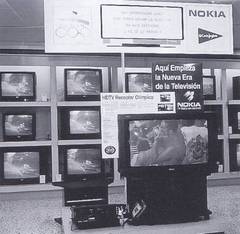
- Nokia Consumer Electronics also took advantage of the major events taking place in 1992 to promote HDTV. Twenty 16:9 receivers were installed in various locations in Spain alone. They included the Expo 92 in Seville, the press rooms in Barcelona, Le Magdalena Palace in Santander, and in several stores of Spain's main department store chain El Corte Ingles. The photo shows an Olympic receiver in the El Corte Ingles store in Madrid.
Several Eureka 95 participants set up viewing sites (Anmerkung: die HDTV-Fernseher und HDTV-Beamer). Equipment manufacturers Philips, Thomson and Nokia report the following:
PHILIPS
About 300 of Philips' Olympic Receivers were installed and serviced in approximately 150 viewing sites in 17 different countries. Viewers were invited to watch high definition pictures of the Olympic Summer Games here. The broadcasts resulted in very positive reactions, especially from the Expo '92 in Seville, where it was almost impossible to close the viewing sites in the pavilions at the scheduled time of 22:00 hr. because of the many people watching the Games. A large number of enthusiastic viewers at the Expo also "borrowed" chairs from elsewhere in the pavilions, thus severely obstructing the traffic flow of visitors.
THOMSON
Thomson Consumer Electronics (TCE) was in charge of more than 210 viewing sites spread around Europe. In addition, HDTV was promoted via Thomson's own retailer network, in several institutional sites such as ministries, and at major broadcasting headquarters. One of the biggest Eurosites was the one in Porto, Portugal, where more than 15 of Thomson's 36" Space System receivers and one Seleco front projector with a 170" screen were installed in a huge theatre. Well over 50,000 people visited this site. Among the most prestigious sites in Spain were the "royal" viewing site in Albeniz, where an HD monitor was installed especially for His Highness King Juan Carlos, and the Barcelona Science Museum, inaugurated by Mr. Samaranch, chairman of the Olympic Committee.
French retailers were very interested in the HDTV experiment and 95% of them stated they were ready to continue to give HDTV demonstrations.
Vision 1250 at the Expo '92 in Seville
During the six months of the World Expo '92, held from April 20th to October 12th, in Seville, Spain, close to 100 HDTV productions were made. Coordinated by Spanish transmission authority Retevision, many of the programmes were recorded in the Retevision HD studio, while others were made on location.
The programmes deal with different aspects of the Expo: from the interviews with VIP's visiting the Expo to performances of folkloristic groups representing the various exhibitors. They were shown in many of the European pavilions at the fair.
Major events, such as the opening and closing ceremonies as well as large theatre productions and concerts were covered with HDTV mobile units, made available by Vision 1250. The HDTV coverage of other big European events taking place this summer, such as the Roland Garros and Wimbledon tennis tournaments, the Gala Sevillana in the Opera House of Vienna, the European Football Championship in Sweden and the Olympic Games in Barcelona, was channelled via satellite to the Expo and distributed to the European pavilions.
DAILY PROGRAMMING
The "Official Expo Programme", a regular daily HDTV programme coordinated by the European Commission and generated in the Retevision pavilion, were distributed to the pavilions via the N1 network. A second HD-MAC programming, generated either by Laser Disc Players installed in the Retevision pavilion, or by the satellite reception of relevant European events, was distributed via the N4 network. The other two networks of the distribution system installed by Retevision, N3 and N4, were used to transmit HDTV programmes on request.
Key players in the HDTV activities at the Expo 92 were Nokia, Philips, Seleco, and Thomson, who supplied the HDTV display equipment (the so-called 'Olympic Receivers'); Retevision, who planned and installed the HDTV studio and VTR equipment and the distribution network to the pavilions; and the Italian public broadcaster RAI, who planned and installed the HD switching and distribution systems in each of the fourteen pavilions.
COOPERATION AND UNDERSTANDING
A 'Demo Task Force' of Vision 1250, formed by engineers and technicians from the member organisations, was available for technical assistance during the six months of the Expo.
BBC World Service and Philips join together in D2-MAC
BBC World Service Television, a 24-hour general entertainment channel, will be broadcast across Europe in D2-MAC as of mid-Autumn. The signal will be encrypted by means of Eurocrypt M, and subscribers will be able to access the channel by using addressable Smartcards.
Under the terms of a recently signed contract, TV Extra, a Sweden-based company owned by Philips and ConNova, will market BBC World Service Television to cable companies, hotels, SMATV operators and individuals.
BBC World Service Television's Chief Executive Christopher Irwin says: "This new relationship will endure the ongoing success of the BBC's satellite television activities in Europe. It will also link the journalistic and news-gathering strength of the BBC with the technological and marketing expertise of Philips."
Subject to transponder availability, the channel will - in addition to D2-MAC/Eurocrypt transmissions - continue to transmit in the existing PAL format for a period of two months. According to BBC World Services Television's Director of Sales and Distribution Jeff Hazell, the use of Eurocrypt technology will make piracy a thing of the past. Piracy of the channel has been a major problem, holding back the development of BBC World Service Television in Europe.
BBC World Service Television was established in March 1991 as a self-funding subsidiary of the BBC with the objective to make available a worldwide television service in every continent by the end of 1993. The company started its broadcasts throughout ASIA in November 1991. The service was made available throughout Africa in April of this year.
German video magazine conducts HDTV study
The German leading video magazine "Video" published a special section on HDTV in its August issue. In addition to an article about the history of television, "Video" explains what exactly HDTV entails, how HDTV programmes are produced, how the signals are transmitted, and what equipment the consumer needs to watch HDTV.
Furthermore, "Video" conducted a study amongst its readers, who were asked to answer a questionnaire regarding HDTV. The questions concern whether or not readers of the magazine have seen any of the Olympic broadcasts, how they feel about HDTV, if they believe that HDTV has a future and what kind of television equipment they currently have.
At this time, the results of the study have not been made public yet. We will attempt to publish them in our next issue of HDTV report.
Eureka 95 consortium approves Phase III
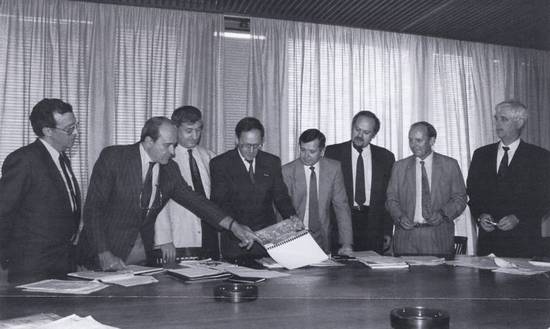
- The Eureka 95 directorate discussing the proposal for the extension of the HDTV project. From left to right: Jose Tartajo (CETEAD, Spain), Enzo Castelli (CISAE, Italy), Dieter Pohl (Bosch, Germany), PietBogels, president (Philips, the Netherlands), Michel Hareng, vice-president (Thomson, France), Helmut Stein (Nokia, Finland), Keith Fuller (Philips, United Kingdom), and Leo de Waal, secretary (Philips, the Netherlands).
In an Eureka 95 consortium meeting held at the RAI headquarters in Rome towards the end of June, representatives of the governments of the European countries accepted EU 95's proposal to continue the HDTV project until the beginning of 1995. The proposal will now be worked out in further detail.
The Eureka HDTV Project EU95, started in 1986, has successfully proposed standards for production and transmission of an HDTV system.
In its first phase (which ended in July of 1990) the feasibility of this compatible HDTV system was demonstrated with prototype hardware and software. Then the project was extended with a second phase aimed at full system evaluation including large scale field testing e.g. during the Olympic Games. This phase will be completed by the end of this year.
Further research and development is necessary to incorporate feed-back from the field tests, fine-tune the standards and create or improve hardware prototypes both for studio and domestic use. Preparations must be made for the implementation of regular HDTV services expected to be launched in 1994.
Austrian HDTV platform launched
An HDTV-information forum organised recently by the Austrian Federal Chamber of Commerce marked the launch of a national Austrian HDTV Forum. Purpose of the platform is to harmonise the differing interests of those sectors concerned and define a uniform strategic programme for the introduction of HDTV in Austria.
Minister of Trade Wolfgang Schussel underlined the importance of HDTV for the Austrian industry, and in particular for a number of high-tech sectors. Mr. Schussel views Austria's close involvement in a number of HDTV projects as an opportunity to secure Austrian export levels in the high-tech sector in the long term. HDTV, he said, was a factor which would affect employment policy in Austria. Mr. Schussel stated that Austria's participation in EC HDTV programmes would be defined by the Federal Government in the nearfuture, and emphasised the willingness on the part of Austria to be fully involved.
OBLIGATION
The general secretary of ORF, Kurt Bergmann, referred to the obligation on the part of ORF as a public institution to test out the latest technology. Cooperation with Japanese broadcasting institutions had, he said, arisen for historical reasons, but this did not represent a turning away from European HDTV developments.
Mr. Bergmann sees the function of ORF in particular as communicating Austria's exceptional cultural achievements to Europe and the rest of the world. He also drew attention to the fact that the introduction of new technology required high levels of investment which could not be financed without extending advertising time in order to safeguard the solidity of ORF's financial basis.
EUREKA 95 at the IBC
Live HDTV broadcasts .... Tennis direct from Wimbledon. Many visitors to the IBC '92 exhibition, held from July 3-7 in Amsterdam, the Netherlands, admired them on a variety of screen sizes from very large projection screens to 28" at the Eureka 95 stand. In addition, one could compare HD-MAC with its compatible D2-MAC picture. Or see perfect images of a photo CD.
In the special section of the stand which was open to invited guests only, Project Groups showed a selection of their work in progress. A large number of EU95 participants made a fine contribution to this part of the stand. The surround sound demonstration by PG 11 was impressive.
A terrestrial test transmission in HD-MAC; improved compatible D2-MAC pictures and demonstrations with a new character generator are just a few of the many other items shown here.
Thomson's Robert Boyer wins IBC 92 award
Robert Boyer, Managing Director of Thomson CFS Laboratories Electroniques in Rennes, France, was the recipient of the prestigious IBC 92 Award. He was given a sculptured glass award, symbolizing the marriage between technology and artistic creation in broadcasting, and a check for 5,000 pounds Sterling for his outstanding personal contribution to the development of digital studio techniques, especially bandwidth reduction and image processing subsystems, that have significantly advanced the course of broadcast technology. The ceremony took place in de Beurs van Berlage in Amsterdam during the IBC Champagne Reception before a large gathering of delegates, exhibitors, and guests.
SUBSYSTEMS AND PROTOTYPE EQUIPMENT
After graduating from the 'Ecole Superieure d'Electricite', Robert Boyer joined Thomson CSF in 1968 where he was initially involved in the development of professional television equipment. Following the creation of a new laboratory in Rennes in 1972, he joined a pioneering team to investigate digital television and soon became head of a section in charge of analogue-digital video activities, coordinating the development of sub-systems and prototype equipment.
By 1979, the key elements of a digital studio (including a synchroniser, router, digital vision mixer, DVE, analogue to digital and digital to analogue converters) had been developed. Mr. Boyer was at that time already investigating the need for serial transmission, as parallel distribution was already perceived to be a major problem.
Around the mid-eighties, Mr. Boyer's team had designed a full scale digital studio with serial interconnections. For the first time the now well-known 'Studio Numerique' in Rennes could be used for the investigation of new protection techniques and marked the real start of the 4:2:2 story.
Over the last five years Mr. Boyer has been active in setting up the management and coordination of works for the development of the European HDTV system within the Eureka 95 Project. In this project Thomson CSF/LER is more particularly involved in the areas of 1250 progressive colour cameras, bit rate reduction coding/decoding and bandwidth reduction system for TV and HDTV transmission and broadcasting (D2 and HD-MAC) - high performance image processing sub-systems for HDTV production and transmission.
Mr. Boyer's most recent achievement has been the design and manufacture of a motion compensation Standards Converter that was used in the Winter and Summer Olympics.
Wimbledon in high definition at the IBC'92
Visitors to the recent International Broadcasting Convention (IBC) in Amsterdam were thoroughly impressed by the quality of the live High Definition Television coverage of the Finals of the Wimbledon Championships being relayed in HD-MAC to the EUREKA 95 stand at IBC. It was the first 'live' HDTV satellite transmission from an event in the UK.
The BBC covered play on the Centre Court at Wimbledon using three BTS/Philips high definition television (HDTV) cameras (one studio-sized and two lightweight CCD cameras) and a specially converted Outside Broadcast production control vehicle. The OB van provided four conventional D1 625 line tape-recorders which were combined to form a single HDTV recorder allowing for continuous recording or editing; the OB vehicle also allowed for production control, mixing and caption generation. Edited highlights of previous play were shown when there was no live action on the Centre Court.
EUROCRYPT
The HDTV pictures were encrypted using Euro-Crypt. A Vision 1250 HD-MAC encoder at Wimbledon converted the HDTV signal, which was then modulated onto a 70MHz carrier. The signal was decoded into base band and the characteristics were changed before being up-linked to the Telecom II satellite for reception in Amsterdam. The decoded pictures were displayed on the Eureka 95 stand on a 16:9 Philips receiver, a Barco frontscreen projector and a splitscreen videowall, by ViDi-Sys/ICT.
It was for the fourth successive-year that the BBC covered play on the Centre Court at Wimbledon using the high definition television (HDTV) equipment.
In addition to the Eureka stand at the IBC 92, the pictures were also relayed to several sites at Wimbledon, to the Expo '92 in Seville. BBC Engineering Research has made fundamental contributions to the Eureka 1250/50 HDTV system. Also, BBC engineers have built an HDTV outside broadcast unit with a special recording system which was used at Wimbledon.
The Press on HDTV: HDTV is ready to go
During the last quarter of 1992 politicians throughout Europe are expected to make far-reaching decisions on the further development of European integration. Far-reaching decisions are also expected with regards to the future of HDTV. The European Telecom Ministers will discuss the Action Plan from the European Commission on November 19th 1992, stimulating the early introduction of HDTV. Technically speaking HDTV is ready to go. In fact, Europe now has the opportunity to exploit a technological advantage.
COUCH POTATOES AND VIDEO PROFESSIONALS
There is plenty of positive press coverage about HDTV, thanks to the successful transmissions this summer from the Olympic Summer Games in Barcelona, the World Expo '92 in Seville, and Wimbledon. Broadcast Magazine (September 1992) announces that there is generally a firm belief in the success of D2-MAC and HD-MAC. "Now it is time for the consumer to make the next step and buy the equipment."
Broadcasting Visions magazine (September 1992) mentions a study where consumers in France, Italy, the U.K., and Germany were approached to see if they would be willing to pay a higher price for a D2-MAC receiver. The challenge was to break the chicken-and-egg situation by creating an installed base of 16:9 television sets. Several groups were approached, and as it turned out, video professionals in France and Italy were willing to pay the most (up to 4.5 times the price of a 4:3 receiver), closely followed by the French trendsetters, the Italian group of people with a high income, and the German retailers. Least likely to spend more money on 16:9 D2-MAC receivers are the German couch potatoes and retailers in the U.K.
On the same subject, Audio-Video Totaal (September 1992), says that D2-MAC television sets, contrary to what people say, are affordable. "There are many misunderstandings about D2-MAC. One can easily watch 4:3 broadcasts on a D2-MAC receiver (sometimes even better so, and if your cable company carries the D2-MAC signals, you don't even need a satellite dish."
CLOSING THE GAP
The large-scale HDTV transmissions during the Summer Olympics were a great success. "We've closed the gap", says BTS-director Pieter van Dalen in the August issue of AV Magazine, referring to the European backlog in HDTV as compared to Japan. The magazine says it may be a bit presumptuous to talk about fault-free transmission and reception, but that HDTV is ready, even though some improvements still should be made.
AV Magazine concludes that the joint partners in HDTV have shown the possibilities of the current technology. "Now work must be done to implement it."
Vision 1250 at the Photokina
Continuing its promotional theme of "Bridging Three Worlds", Vision 1250 was present at the audiovisual trade fair Photokina 32, held in Cologne, Germany on September 16-22.
The European branch of Society of Motion Picture and Television Engineers (SMPTE) held its first three-day conference during the Photokina. On the occasion of this event, Vision 1250 was asked to set up a special HDTV cinema to demonstrate the excellent results achieved through film-to-tape and tape-to-film transfer.
1250/50 HDTV programmes made by Vision 1250 members -including this year's coverage of the Winter and Summer Olympics- were projected
onto a 170" screen, using two Seleco projectors in order to increase the brightness of the images. The projectors were fed by VTR equipment made by BTS and Thomson.
To illustrate the "happy marriage" between 35mm film and 1250/50 HDTV, film-to-tape transfer was demonstrated using a promotional tape made by BTS/Kodak, and tape-to-film transfer through material provided by Cinema L and Ex Machina, the latter projected on a 35mm Kinoton film projector.
During the HDTV screening party, held jointly by Vision 1250 and Photokina organizers Koeln-Messe, invited guests also had the opportunity to see 1250/50 HDTV on direct view monitors.
Vision 1250's Deputy Director General Franco Visintin was among the speakers to present a paper on high definition television at the SMPTE conference. Other speakers included Vision 1250 members Francesco Pinto, Mario Barbero and Roberto Cecatto (RAI), Marcel Breeuwer (Philips), Yves Marie Pannerer (Thomson) and Dieter Poetsch (BTS).
Impressum / Colophon
HDTV Report is a publication of the Eureka 95 HDTV
Directorate
Editorial Staff: EU95 Communications Committee
Production and design: Smulders Corporate & Marketing
Communications B.V., the Netherlands
Information: Eureka 95 Communications Committee,
P.O. Box 523, NL 5600 AW! Eindhoven,
The Netherlands, telephone: +31 40 758329,
telefax:+31 40 757319
© Eureka 95,1992
Articles may be reproduced in whole or in part provided that the source 'Eureka HDTV Report' is mentioned in full; photographs and drawings for this purpose are available on request. The editors would appreciate a complimentary copy.

